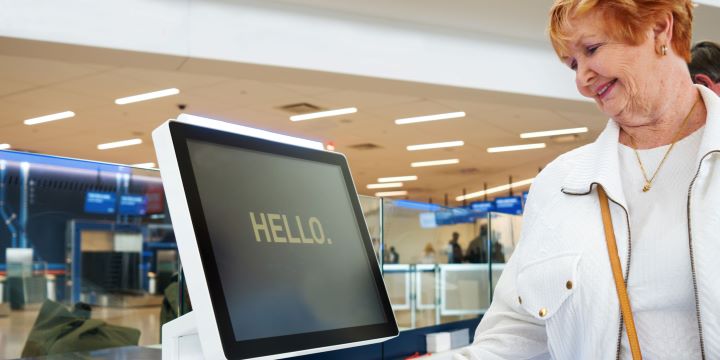Key Takeaways:
- Interactive healthcare kiosks provide convenient self-service options for patients, improving their overall experience within healthcare facilities.
- Kiosks offer measurable benefits in operational efficiency, reducing wait times and administrative workloads, which can directly enhance patient care.
- The rise of intelligent kiosk technology, with features like AI integration, is poised to revolutionize patient-healthcare provider interaction further
Table of Contents:
- Introduction to Healthcare Kiosks
- Types of Healthcare Kiosks
- Advantages of Healthcare Kiosks for Patient Care
- Impact of Interactive Kiosks on Healthcare Staff Efficiency
- Case Studies: Healthcare Kiosks in Action
- Challenges and Solutions in Kiosk Implementation
- The Future of Healthcare: Trends in Kiosk Technology
- Best Practices for Choosing the Right Healthcare Kiosk
- Measuring the Success of Healthcare Kiosks
Introduction to Healthcare Kiosks
Healthcare systems continually aim to improve the patient journey, and a critical factor in this pursuit is incorporating technology within clinical environments. A standout innovation in this arena is the medical kiosk, an interactive station that streamlines various administrative and patient-facing tasks. This technology introduces efficiency and autonomy into the healthcare experience, reducing patient and provider stress. By enabling patients to perform tasks such as registration efficiently and accessing personal health information, these medical kiosk are a linchpin in the digital transformation of healthcare services.
Not just a tool for expediting check-in processes, healthcare kiosks have evolved to become multifunctional touchpoints that can communicate vital information, guide visitors through expansive hospital complexes, and even facilitate financial transactions securely. They represent a convergence of innovation and patient-centric care, emphasizing the importance of user experience in healthcare settings.
Types of Healthcare Kiosks
Healthcare kiosks are diverse in design and function. Some are developed for specific tasks, while others are multifunctional. Predominantly, you’ll find:
- Check-in and Registration Kiosks: Offering a fast and private way for patients to check in for appointments, fill out pre-visit questionnaires, and even issue ID bands, streamlining the arrival process.
- Informational and Wayfinding Kiosks: These provide interactive maps and directories, helping patients and visitors navigate complex healthcare facilities efficiently and access health-related information.
- Prescription Refill and Payment Processing Kiosks: For a convenient way to manage prescriptions and make payments, these kiosks reduce the time spent on administrative tasks for patients and staff, often integrating with pharmacy systems for seamless service delivery.
Advantages of Healthcare Kiosks for Patient Care
Kiosks in the medical field have proven to have a notable impact on patient care. The self-service model fosters an environment where patients experience reduced wait times and greater control over their healthcare processes. Kiosks have the added benefit of protecting patient privacy, offering a secure platform for individuals to access personal health records without conveying sensitive information verbally in public spaces.
Moreover, the introduction of kiosks often leads to enhanced patient engagement. By streamlining routine tasks, patients can manage their healthcare needs more independently. This level of engagement can leave patients feeling empowered and satisfied with their healthcare experience, fostering better patient-provider relationships.
Impact of Interactive Kiosks on Healthcare Staff Efficiency
Interactive kiosks benefit patients and are highly valued by healthcare staff. These automated systems significantly reduce clerical workloads, freeing staff to focus more on patient care than administrative duties. Better allocation of human resources means that healthcare providers can devote more attention to what matters most—the patient.
Regarding data management, the touchpoints allow for accurate patient information inputs, leading to fewer administrative errors. This heightened accuracy is instrumental in avoiding miscommunication, ensuring proper billing, and maintaining high standards of patient care.
Case Studies: Healthcare Kiosks in Action
Case studies testify to the value that healthcare kiosks add to medical institutions. For instance, in some emergency departments, introducing patient self-service kiosks has led to a marked decline in registration times, contributing to greater efficiency in patient triage. Further examples showcase kiosks assisting with language translation, increasing accessibility for non-English speaking patients, and ensuring that language barriers do not impede the quality of care.
These accounts extend beyond primary care facilities. Specialty clinics and hospitals with integrated kiosks report improved patient feedback, with many experiencing more streamlined workflows. These qualitative and quantitative benefits are echoed in several industry publications, which emphasize how technological advances such as healthcare kiosks are at the forefront of enhancing patient care.
Challenges and Solutions in Kiosk Implementation
Despite their numerous benefits, healthcare kiosks present challenges that must be addressed. A primary concern is maintaining the confidentiality and security of patient health information accessed and entered through these kiosks. Implementing robust security measures and ensuring compliance with healthcare regulations, such as the Health Insurance Portability and Accountability Act (HIPAA), is essential for protecting patient data.
Technological integration can also be a hurdle, as the kiosk system must effectively communicate with existing healthcare IT infrastructure to provide a seamless user experience. Adequate staff training and ongoing technical support are integral to overcoming such challenges and ensuring the kiosks operate as intended.
Accessibility is a legal and ethical imperative; provisions such as adjustable screen height, audio output, and easy-to-navigate interfaces help ensure that everyone, including those with disabilities, can use kiosks.
The Future of Healthcare: Trends in Kiosk Technology
Emerging trends in healthcare kiosk technology signal a future in which these devices can offer increasingly advanced services, such as integrating AI to provide personalized health reminders or triage symptoms. Innovations in machine learning algorithms could enable healthcare kiosks to predict patient needs and even suggest follow-up care based on historical data and patterns, offering a truly interactive experience that can adapt to individual patient requirements.
Futuristic kiosks also extend their role to virtual care, creating a hybrid model that blends the efficiency of kiosks with the personal touch of virtual healthcare consultations. This could be incredibly impactful in remote areas, where such innovations could help bridge the gap between patients and healthcare providers.
Best Practices for Choosing the Right Healthcare Kiosk
Selecting the appropriate healthcare kiosk for a facility is contingent on various criteria. User experience is paramount, and features such as intuitive interfaces, responsive touch screens, and accessible design are crucial. Ensuring that kiosk design meets ADA guidelines is a regulatory obligation and a commitment to inclusivity.
Partnering with an experienced and reliable vendor can significantly influence the success of kiosk implementation. Providers should seek suppliers who understand healthcare environments’ unique needs and can offer tailor-made solutions with comprehensive support and customization options.
Measuring the Success of Healthcare Kiosks
Qualitative and quantitative assessments are essential to measure healthcare kiosks’ impact effectively. Patient satisfaction can be gauged through well-designed feedback systems embedded within the kiosk or through independent surveys. Operationally, metrics such as reduction in patient wait times, increased throughput, and data entry accuracy indicate kiosk efficacy.
Financially, the return on investment in kiosk technology can be significant. By automating routine tasks, healthcare providers can reduce labor costs and minimize billing errors, translating into cost savings over time. Assessing these metrics enables healthcare organizations to make informed decisions about scaling or modifying their kiosk systems.




